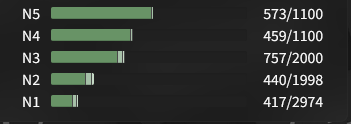Hey, I am new to the forum. It seems to be thriving community, so I am trying my luck to start a thread summarizing my journey after 10 levels.
My Progress
- I started with 0 knowledge of Japanese. I don’t watch Japanese media much to a have a basic feel for the language like many do.
- Finishing WaniKani Level 10. That is 123 days, about 12 days per level. This speed is about average and I am glad that I am not skipping too many reviews.
- Started working on N5 grammars on Bunpro.
How I feel:
- Reading is extremely difficult - reading a sentence from which I know all the vocabulary and grammar points is still a struggle. I have to mentally translate each part of the sentence first (especially the pronunciations) and then read it out loud together.
- Listening and understanding at regular Japanese talking speed is impossible. The speed is just too much for my brain to process.
Unexpected findings:
- Learning Japanese is fun - studying vocabulary is a great way to fill in fragmented free time throughout the day. In fact, I have been traveling much during the period, but I have rarely miss a single day of study.
- Learning enforce memory: recalling vocabulary often brings me back to the physical situations I was in when I first learn the word (especially on travels).
Questions for the community - how to progress?
- How do yall structure your learning journey at this level?
- Are their reading material or online tools to help me internalize grammar and learned vocabularies?
- Do yall use or need another site for vocabulary? IMO, WaniKani vocabularies focuses more on “smooth Kanji progression”, rather than teaching you everyday common phrases.


